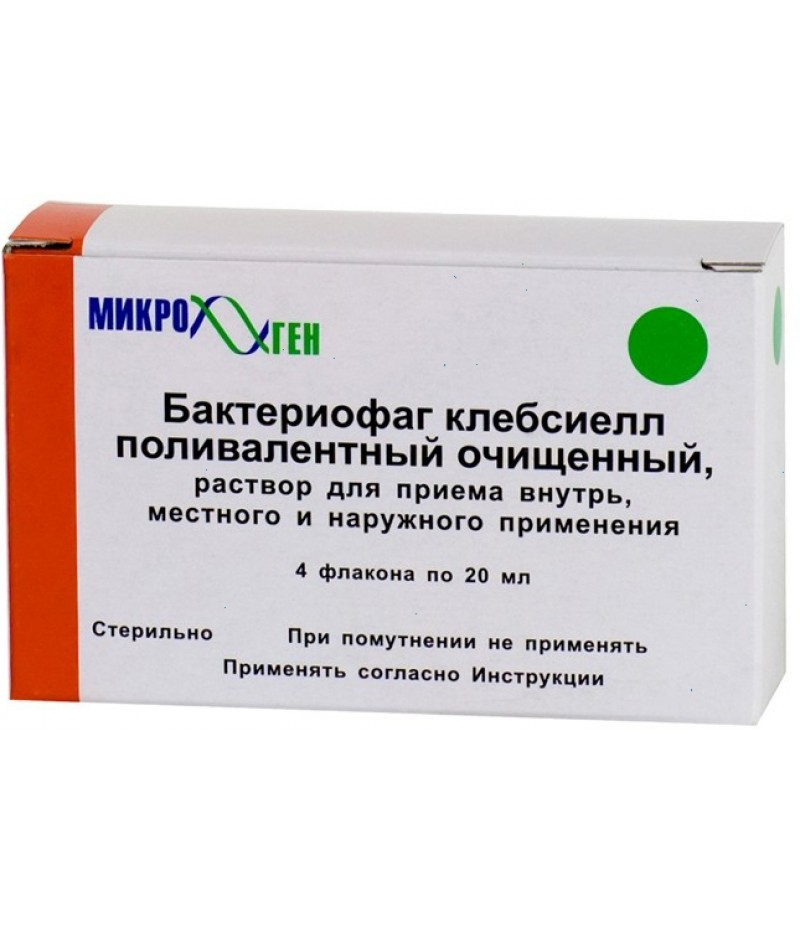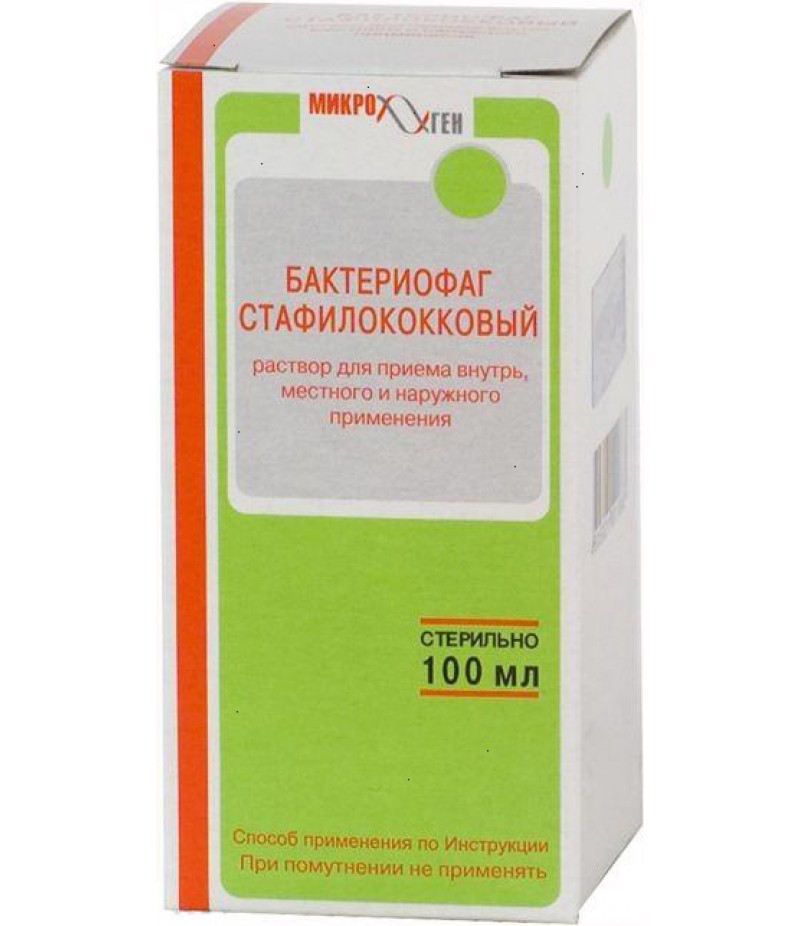Bacteriophag Klebsiell 20ml #4
- $51.11
- 2 or more $49.00
- 3 or more $45.75
- Availability:In Stock
Instruction for BacteriophagYou can buy Bacteriophag on this pageCompositionOne bottle of Bacteriophage Klebsiella Polyvalent Cleansed contains 20 or 10 ml of a mixture of filamentate filtrates Klebsiella ozaenae, pneumonia and rh..
Instruction for Bacteriophag
You can buy Bacteriophag on this page
Composition
One bottle of Bacteriophage Klebsiella Polyvalent Cleansed contains 20 or 10 ml of a mixture of filamentate filtrates Klebsiella ozaenae, pneumonia and rhinoscleromatis.
Additional substances: 8-hydroxyquinoline sulfate monohydrate.
Form of issue
Yellow transparent solution of different intensity:
20 or 10 ml in a glass bottle - four bottles in a cardboard bundle;
20 or 10 ml in a glass bottle - ten bottles in a cardboard bundle;
20 or 10 ml in a glass vial - four vials in a contoured package; one package in a cardboard box.
pharmachologic effect
Antibacterial action.
Pharmacodynamics and pharmacokinetics
The preparation Bacteriophage polyvalent klebsiella causes selective destruction of microorganisms Klebsiella ozaenae, pneumoniae and rhinoscleromatis.
Indications for use
Therapy and prevention of diseases caused by Klebsiella ozaenae, pneumoniae and rhinoscleromatis in the composition of polycomponent treatment:
lesions of the digestive tract (gastroenterocolitis, pancreatitis, cholecystitis, intestinal dysbacteriosis);
ozona, scleroma;
diseases of young children and infants of an inflammatory nature (intestinal dysbacteriosis, gastroenterocolitis, pemphigus, omphalitis, septicemia, pyoderma, septicopyemia);
surgical diseases (purulent skin diseases, suppuration of wounds, peritonitis, burns, pleurisy, osteomyelitis, mastitis, abscess);
urogenital infections (pyelonephritis, cystitis, urethritis, vulvitis, colpitis, endometritis, bartholinitis, salpingo-oophoritis);
diseases of the ear, nose, throat, pharynx, oral cavity, bronchi, larynx, lungs, pleurisy of purulent-inflammatory nature (angina, otitis, laryngitis, pharyngitis, periodontitis, stomatitis, frontalitis, maxillary sinusitis, pneumonia, bronchitis, pleurisy);
conjunctivitis of post-traumatic origin, corneal ulcer, keratoconjunctivitis, iridocyclitis;
prevention of hospital infections associated with Klebsiella.
Contraindications
Sensitization to the drug.
Side effects
Side effects after eating the drug is not revealed.
Instructions for use Bacteriophag Klebsiell polyvalent (Method and dosage)
The instruction allows the use of the Klebsiosis polyvalent bacteriophage inside, in the form of irrigation, applications, enemas, insertion into the nasal cavity, wound, uterus, vagina, sinuses, and also for the drainage of abscesses, bladder, abdominal and pleural cavities, renal pelvis. Orally take a drug per hour of food, on an empty stomach.
Recommended dosages for patients older than 8 years are up to 30 ml of the solution for oral administration and up to 50 ml when administered as enemas. Treatment of localized diseases of a purulent-inflammatory nature should be carried out by combining local therapy and taking the drug inside.
In the treatment of oes or scleroma, the remedy is used to sanitize the nasal cavity and mucocutaneous airway, to be inserted into the sinuses of the nose, and also in the form of inhalations when the larynx, pharynx, and trachea are affected. The dose in the treatment of mucosal airways is 10-20 ml. After the sanitation of the mucous membranes in the nasal passages, in turn, the turunds impregnated with the drug are introduced and they are left for one hour. This procedure is repeated up to three times a day for 5-6 weeks. Since ozona and scleroma are chronic diseases, in order to prevent exacerbations it is advised to conduct similar courses of treatment once a year.
In the treatment of laryngitis, pharyngitis, angina remedy, 15-20 ml are used to sanitize the oropharyngeal cavity three times a day for 9-10 days.
In the treatment of bronchitis and pneumonia, the drug is ingested up to 20 ml three times a day and is used in the form of inhalations and aerosols. The duration of such therapy is up to 3 weeks.
When treating otitis media, the remedy is used to rinse and sanate the ear cavity 4-5 ml three times a day. The course of therapy is designed for 1-2 weeks.
In the treatment of inflammatory diseases of the sinuses, nose and nasopharyngeal washings are carried out with 7-10 ml of the drug solution and sanation of the sinuses 3 ml. This procedure is carried out once a day for 9-10 days. Also, the drug is injected into the nasal cavity in the form of turundas, impregnated with a bacteriophage, in each nasal pass in turn and left for 1 hour. This procedure is performed three times a day for two weeks.
When treating chronic periodontitis and stomatitis, rinses the oral cavity with 15-20 ml of the drug up to 4 times a day, produces turund with the drug in the periodontal pockets for 10 minutes. The duration of such treatment usually does not exceed ten days.
With keratoconjunctivitis and conjunctivitis, the drug is digested 3 drops up to five times a day for a week; with purulent iridocyclitis, 7 drops are injected up to 8 times a day together with ingestion in standard doses for 10 days; when the purulent ulcer of the cornea area is digested 5 drops a day for ten days.
With abscesses after the cavity is empty, the drug is injected daily for 10 days.
In pleurites and peritonitis, drain the cavity of 20-70 ml of the drug through the drainage tubes once a day for two weeks.
In osteomyelitis, the agent is injected into the wound with turundum and drains of 10-30 ml daily. Treatment lasts up to three weeks.
In the treatment of wound suppuration by means of irrigation, application and apply it in the form of bandages, enter into the drainage of 5-50 ml at least 1 time per day for 11-15 days.
With the treatment of gynecological diseases of purulent-inflammatory nature (endometritis, suppuration of wounds, vulvitis, colpitis, bartholinitis, salpingo-oophoritis), the agent is used for applications, irrigation, injected into the uterine cavity, wounds, vaginas 10-20 ml once a day for 9-10 days.
With pyelonephritis, cystitis, urethritis, the drug is taken orally inward at a therapeutic dose up to three times a day on an empty stomach for 2-3 weeks. If the cavity of the renal pelvis or bladder is drained, then the agent is administered through drains of 20-40 ml into the bladder or 5-6 ml to the renal pelvis up to three times a day. The therapy lasts 1-2 weeks.
With pancreatitis, gastroenterocolitis, cholecystitis, intestinal dysbacteriosis, Klebsiella Bacteriophage is administered orally at age dosages up to three times a day on an empty stomach for 1-2 weeks. With indomitable vomiting, a remedy for 20-40 ml is used in the form of high enemas three times a day.
To prevent hospital surgical infections Bacteriophage polyvalent Klebsiella is used to treat freshly infected and postoperative wounds for 5-50 ml daily once a week.
Use of the drug Klebsiella Bacteriophage for infants and children younger than the year
With gastroenterocolitis, sepsis and pneumonia of newborns, the drug is used orally 3-4 ml 3 times a day for half an hour before feeding. With indomitable vomiting, the bacteriophage is used for 5-8 ml in the form of high enemas once a day. The duration of treatment leaves 1-2 weeks.
In order to prevent the onset of hospital infection in newborns, the drug is used orally for 3-5 ml three times a day, half an hour before feeding during the entire stay in the hospital.
In the treatment of pyoderma, omphalitis, infected wounds, 5-10 ml of the solution is used for applications up to 3 times a day for 1-2 weeks.
Overdose
There are no reports of such cases.
Interaction
The drug is allowed to combine with anti-inflammatory and antibacterial agents.
Terms of sale
Without recipe.
Storage conditions
Keep away from children. Store in a dark place at a temperature of 2-8 degrees.
Shelf life
2 years.
special instructions
Before using the vial with the drug, it is necessary to shake and assess its transparency and the presence of sediment. If turbidity or sediment is detected, the drug is prohibited!
Due to the presence in the preparation of a favorable climate for the development of microorganisms from the environment that cause turbidity of the solution, the vial should be opened according to the following rules:
hands must be thoroughly washed;
Before removal, the cap should be treated with an alcohol solution;
remove the cap without removing the stopper;
the preparation from the opened container should be selected only by piercing the plug with a sterile syringe;
if the plug was accidentally uncorked during the autopsy, then it should not be placed on the table with the internal surface, and the bottle should not be left open (after removing the product it must be closed with a stopper);
The opened vial should be stored in the refrigerator.
If these rules are observed and there is no turbidity, the agent from the opened bottle is allowed to be used throughout the shelf life.
Children
Standard doses of the drug for children under 6 months are 5 ml when administered orally and 10 ml when used as an enema; for children 6-12 months - 10 ml when administered orally and 20 ml when used as an enema; for children 1-3 years - 15 ml when administered orally and 20-30 ml when used as an enema; for children 3-8 years - 20 ml when ingested and 30-40 ml when used as an enema. Adult doses are used in children older than eight years old.
Newborns
The standard dose for newborns is 5 ml of the drug for ingestion and 10 ml when used as an enema.
In pregnancy and lactation
It is possible to use the drug in the periods indicated by the supervision of the attending physician.
Reviews for Bacteriophag Klebsiell polyvalent purified
Feedback when using this drug is very contradictory, but the overall picture is evidence of its effectiveness. There are many reports that there is no effect on admission in the treatment of intestinal dysbiosis in infants.
There are no side effects.


